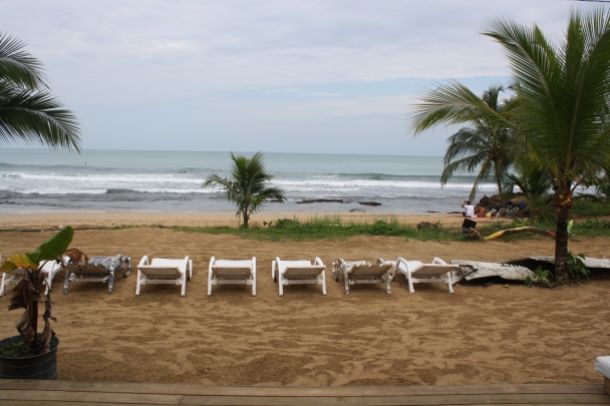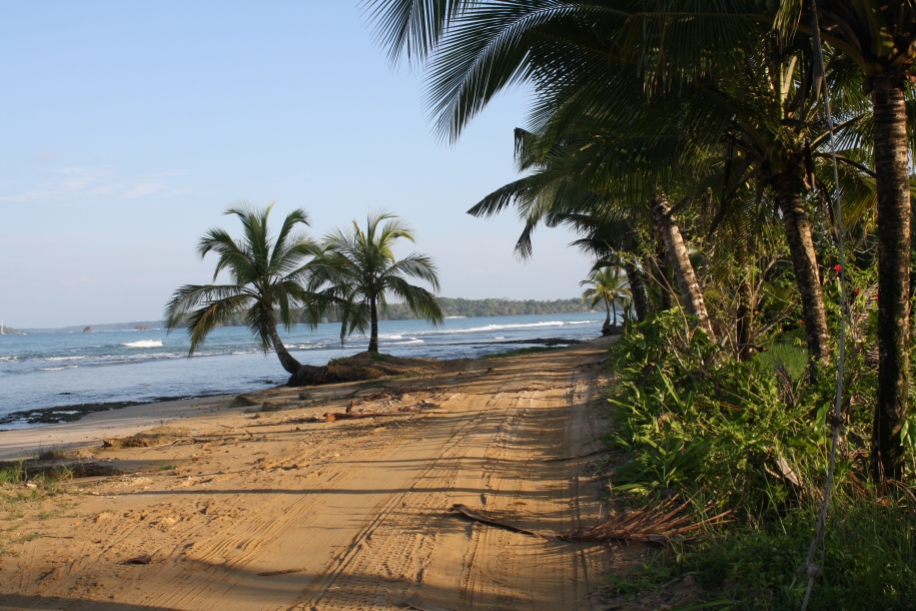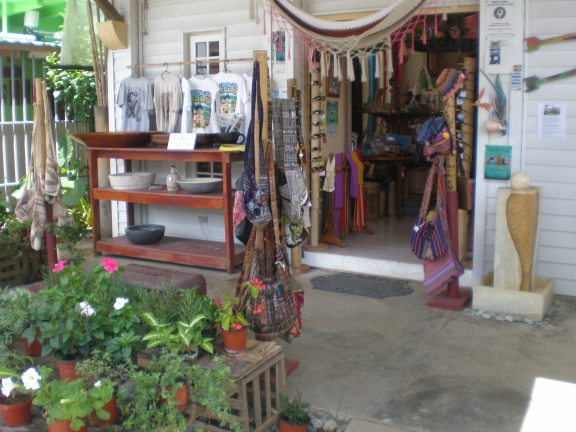Attitude of Gratitude:
I’m thankful that I’m no longer getting bit by Panamanian bugs. I’m thankful for the days I’ve been starting with delicious, balanced, home-cooked breakfasts. I’m thankful that I overheard my British friend and her Mom skyping about knickers and the laughing that ensued. Read my previous blog post here to learn about my attitude of gratitude.
I’ve always loved the idea of suspension. Of being in two places at once, of being between two ideas, two realities. Crossing the border from Costa Rica to Panama on foot on a rainy day over an unstable, slippery bridge wasn’t as romantic as my thoughts of suspension. The wooden bridge had an old railroad track down the middle with wide open gaps between some steps. Boards shook when you stepped on them. Between the gaps the dirty river raged below.
Entering y Exiting Costa Rica:
As a United States citizen you don’t need a visa to enter Costa Rica. All you need is your passport and proof of leaving within 90 days. Once the 90 day mark comes, you need to leave the country for 72 hours before you can return. For more information about traveling to Costa Rica as a United States citizen head to the U.S. Department of State’s page here.
Many people recommended Bocas del Toro, islands of the northwest coast of Panama, and my friend from the States was heading there, so it was perfect time for a border run.
Logistics of a border run:
My friend and I started in Cahuita, a town on the Caribbean side of Costa Rica. If starting in Cahuita, make sure you have colones at the bus station to pay for a bus ticket. They wouldn’t accept American dollars. We missed the bus because of this. But also make sure you have American dollars before you enter Panama because that’s the currency in Panama.
From Cahuita we took the 10 a.m. bus to the border town of Sixaola. We were confused because we heard people say Sixaola and thought they were saying six hours. It took two hours to get to Sixaola from Cahuita. The bus deposited us at the bottom of the hill at the end of town. The only way to go was forward, towards the bridge. Before walking across the bridge we had to go to the immigration office on the right. We had to fill out an immigration form and get an exit stamp from Costa Rica. Once in Panama we could have walked right into the country without anyone stopping us. We walked into another country like we were walking home from a neighbor’s house.
Once off the bridge there’s a border office to the left to get an entrance stamp. Like Costa Rica, in order to enter Panama you need proof that you’re leaving. I was able to show my flight out of Costa Rica as proof. My friend had to buy a bus ticket from the stand down the stairs on the side of the big building. For $14 he bought a ticket that was valid for a year. He had to write his name and passport number on the ticket. The whole border process took about an hour. There was no fee to enter Panama.
On the Panama side there were a lot of people just hanging around, watching. I didn’t feel threatened but it was a little unnerving. Most of them seemed like they were just trying to make money by helping. We took a van(one of the men hanging around was advertising the shuttle service) for $10 to the port where we took a boat for $4 to Bocas Town. Once we got into the van, the soundtrack of old school Ja Rule and 50 Cent gave me hope for the way things were working out. But once we got to Bocas Town, I quickly learned that it wasn’t where I wanted to spend my time.
Bocas Town, Bocas del Toro, Panama
Bocas Town is a small slice of a town at the bottom of Isla Colón. It’s the most developed and most visited area of the six islands that make up the Archipiélago of Bocas del Toro. Isla Colón is named after Christopher Columbus, who sailed to Bocas del Toro in 1502. The islands eventually turned into Chiquita banana plantations. Workers came from Jamaica and the West Indies, which increased the Caribbean vibe. Now there are hotels along the water, homes raised on stilts that are painted vibrant colors with a mix of tropical and colonial porches, and tons of water-activity based tours to go on.
Who names paradise?
For the first time in my travels I experienced what people deem “paradise” right alongside stark poverty. Being in Bocas Town made me feel sad and uncomfortable. Being there made me feel like I should be doing something to help instead of bar-hopping like most people. I started thinking about who deems a certain place paradise and how someone else could experience it completely differently. It looked like the locals were getting pushed out to construct hotels and places for visitors. Many areas were littered with trash and many locals homes were just piles of wood planked together. Are the locals enjoying the islands for the turquoise water and pristine beaches or are foreigners the only ones able to enjoy all the paradisiacal activity? It was also my first stop that wasn’t a backpackers’ town and instead a place where wealthy people vacation. I wasn’t used to not seeing smiling passer-bys on the street, not being able to find a decently priced meal containing vegetables and not freely going up to strangers to chat.
Here are some homes in Bocas Town:
There were places I enjoyed in Bocas Town, but I think three days is enough to experience what Bocas Town has to offer.
My suggestions:
-Rent a bicycle and ride out of Bocas Town towards the main part of the island. Ride towards Playa Bluff. Before the beach there’s a cool lounge on the water called Paki Point. Great place to chill, eat, drink. Playa Bluff was one of the most beautiful beaches I’ve been to.
-For food: Bocas Blended. A food truck two doors down from Tropical Markets, next to a house with a sign that says Marisqueria. It’s on the road along the water. I had a Mediterranean veggie wrap, Thai salad and mojito lemonade for $7. Any combination of wrap, salad and drink is $7. So fresh and delicious. I would definitely go again.
La Casbah: Located on Av. Norte between Calles 3 and 4. Very fresh food and reasonably priced. I had a falafel plate with pita and veggies on the side for $6.50. Split bruschetta for $5.50. Great atmosphere.
La Buga: on the water. Had good veggie options for lunch.
Cosmic Crab: on Isla Carenero. Need to take a $1 water taxi from Bocas Town. Right on water. Great place to go for sunset. Good specials.
Favorite store: Island Traders. Two doors down from police station. They have traditional mola patches, unique jewelry, beautiful displays of local art, among other things.
Favorite place to take yoga: Bocas Yoga. In a big purple house. For $5 you can’t beat it.
Cool hostels in Bocas Town:
Casa Verde (right on the water), Mondo Taitu (a party hostel), Mare Iguana (not in the center of town), Hostel Hansi
The inevitable thing in Bocas:
I can’t blog about Bocas without writing about the bugs there. I’m naturally prone to bug bites, so I might be a little biased. But out of all the years of my life of constant bites, swelling and infections, I’ve never experienced bites to the degree that I did in Bocas. Bocas is known for its invasion of no-see-ums or sand flies. In clusters they attacked my ankles and pretty much every part of my body. After itching them they would burn for hours. This hasn’t happened to me with other bites. I’d wake up in the middle of the night to partake in scratch-a-thons. I wouldn’t be able to fall asleep. No bug spray or medicine helped. I did use a relief oil that I bought on the island. “Stop Scratchin Bite Relief” had jackass bitters, mataratton, aloe vera, coconut oil and beeswax. This helped but I had to apply it constantly.
If you have any questions at all about more information in Bocas or want to know more specific details about what I mentioned, message me or leave a comment and I’d be happy to help.
One last thing
I can’t write about Bocas without mentioning Sweet Love. Sweet Love was graffitied everywhere. You couldn’t walk down the street without it making an appearance. I’m not exactly sure why or where it came from, but there’s no denying that sweet love makes everything better. Here’s hoping there’s more sweet love for all of us.













